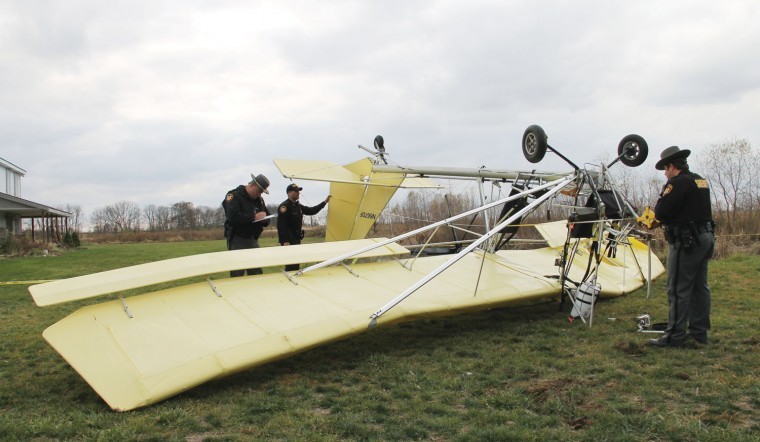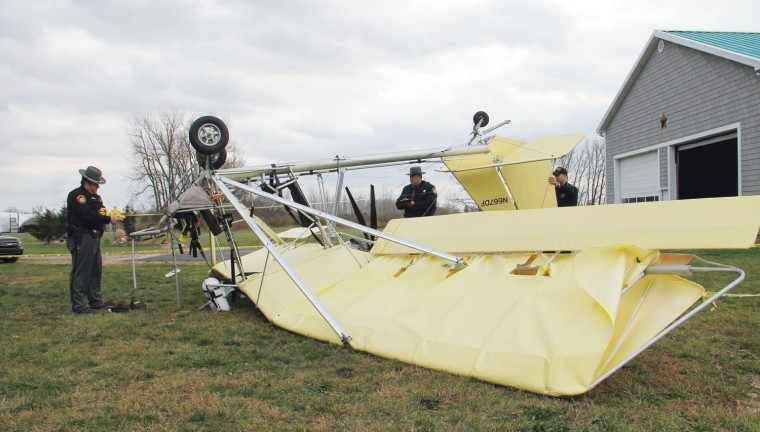FYI - From the N667DF number on the tail:


Kathryn's Report
SUNDAY, NOVEMBER 4, 2012
Dragonfly-C, N667DF: Accident occurred November 04, 2012 in Darbyville, Ohio (and) Accident occurred September 26, 2010 in Orient, Ohio
Aviation Accident Final Report - National Transportation Safety Board:
http://app.ntsb.gov/pdfDocket And Docket Items - National Transportation Safety Board:
http://dms.ntsb.gov/pubdmsAviation Accident Data Summary - National Transportation Safety Board:
http://app.ntsb.gov/pdfNTSB Identification: CEN13LA055
14 CFR Part 91: General Aviation
Accident occurred Sunday, November 04, 2012 in Darbyville, OH
Probable Cause Approval Date: 09/30/2014
Aircraft: CENTRAL OHIO DRAGONFLY CLUB DRAGONFLY-C, registration: N667DF
Injuries: 1 Serious.
NTSB investigators may not have traveled in support of this investigation and used data provided by various sources to prepare this aircraft accident report.
The accident occurred during an aero-tow of a hang glider. The pilot reported that during initial climb, about 80 feet above the runway, the airplane experienced a sudden and total loss of engine power while it was in a climbing left turn. He stated that the airplane immediately entered an aerodynamic stall/spin following the loss of engine power. The pilot released the towed hang glider, but he was unable recover from the aerodynamic stall condition before the airplane impacted terrain. A postaccident examination of the two-cylinder engine revealed excessive piston scoring within one of the cylinder assemblies and excessive wear on the piston wrist-pin. The observed anomalies were consistent with a cold-seizure event. A cold-seizure event is a thermo-imbalance condition between the piston and cylinder, which results in an insufficient clearance between the piston and the cylinder. The cylinder thermo-imbalance condition is typically the result of an insufficient engine warm-up period before takeoff power is applied. However, the conditions that led to the cold-seizure event may not have been limited to the accident flight. The total loss of engine power during initial climb, while towing a hang glider, likely contributed to the aerodynamic stall/spin encountered at a low altitude. Additionally, the low altitude at which the aerodynamic stall/spin was encountered was likely insufficient to have allowed a recovery before the airplane impacted terrain.
The National Transportation Safety Board determines the probable cause(s) of this accident as follows:
The total loss of engine power due to a cold-seizure event that occurred at a low altitude, which precluded the pilot's recovery from an inadvertent aerodynamic stall/spin.
On November 4, 2012, about 1230 eastern standard time, an experimental Dragonfly-C airplane, N667DF, was substantially damaged when it collided with terrain following a loss of engine power during initial climb from WesMar Aerodrome, a private airstrip located near Darbyville, Ohio. The private pilot was seriously injured. The airplane was registered to and operated by Central Ohio Dragonfly Club, LLC, under the provisions of 14 Code of Federal Regulations Part 91 without a flight plan. Day visual meteorological conditions prevailed for the local area hang glider aero-tow flight that was originating at the time of the accident.
The pilot reported that during initial climb from runway 5 (2,300 feet by 60 feet, grass/turf), about 80 feet above the runway, the airplane experienced a sudden and total loss of engine power while it was in a climbing left turn. He stated that the airplane immediately entered an aerodynamic stall/spin following the loss of engine power. The pilot released the towed hang glider, but he was unable recover from the aerodynamic stall condition before the airplane impacted terrain. The airplane sustained substantial damage to the fuselage and both wings. The pilot reportedly sustained a broken left ankle.
A postaccident examination of the two-cylinder Rotax model 582 engine, completed by a Federal Aviation Administration Inspector, revealed excessive piston scoring within one of the cylinder assemblies. Additionally, there was excessive wear observed on the piston wrist-pin. The observed anomalies were consistent with a cold-seizure event, as described in a service training publication provided by the engine manufacturer. The engine manufacturer described a cold-seizure event as a thermo-imbalance condition between the piston and cylinder, which results in insufficient clearance between the piston and the cylinder. Additionally, the engine manufacturer stated that the cylinder thermo-imbalance is typically the result of an insufficient engine warm-up period before takeoff power is applied. The engine, serial number 5742422, had accumulated 205 hours since new.
http://registry.faa.gov/aircraftinquiry/N667DFNTSB Identification: CEN13LA055
14 CFR Part 91: General Aviation
Accident occurred Sunday, November 04, 2012 in Darbyville, OH
Aircraft: CENTRAL OHIO DRAGONFLY CLUBLLC DRAGONFLY-C, registration: N667DF
Injuries: 1 Minor.
This is preliminary information, subject to change, and may contain errors. Any errors in this report will be corrected when the final report has been completed. NTSB investigators may not have traveled in support of this investigation and used data provided by various sources to prepare this aircraft accident report.
On November 4, 2012, about 1245 eastern standard time, a Dragonfly-C, N667DF, experienced a total loss of engine power during takeoff, and collided with terrain near Darbyville, Ohio. The pilot, the sole occupant of the aircraft, received minor injuries. The aircraft received substantial damage to both wing spars and the vertical stabilizer. The aircraft was registered to a limited liability corporation and operated by an individual under the provisions of 14 Code of Federal Regulations Part 91 as a personal flight. Visual meteorological conditions prevailed for the flight, which operated without a flight plan. The airplane had just departed the WesMar Aerodrome, Orient, Ohio.
According to a statement provided by the pilot, the airplane was towing a hang glider, and was about 80 feet above ground level when the engine stopped producing power. The hang glider was released and the pilot attempted to perform a forced landing. The engine was retained for further examination.
NTSB Identification: CEN10CA569
14 CFR Part 91: General Aviation
Accident occurred Sunday, September 26, 2010 in Orient, OH
Probable Cause Approval Date: 03/16/2011
Aircraft: CENTRAL OHIO DRAGONFLY CLUBLLC DRAGONFLY-C, registration: N667DF
Injuries: 2 Minor.
NTSB investigators used data provided by various entities, including, but not limited to, the Federal Aviation Administration and/or the operator and did not travel in support of this investigation to prepare this aircraft accident report.
The pilot planned for a short local flight with a passenger between his continuous aero-tow operations. In an effort to expedite the quick passenger flight, the pilot disconnected the tow line; however, he left the V-Bridal line attached to the rudder post of the airplane. The pilot had conducted previous flights in the same configuration without incident. During taxi, the pilot turned the airplane 180 degrees to position it for an upwind takeoff. Shortly after rotation, the pilot experienced an uncommanded right turn. He attempted to counteract the turn to no avail. The airplane impacted terrain with the right wing and right main landing gear. Examination of the airplane by the pilot and a Federal Aviation Administration inspector revealed the V-Bridal line became entangled in the rudder and tailwheel during the takeoff.
The National Transportation Safety Board determines the probable cause(s) of this accident to be:
The pilot's failure to disconnect the tow bridal line prior to takeoff.
The pilot planned for a short local flight with a passenger between on-going aero-tow operations. In order to expedite the quick passenger flight, the pilot disconnected the tow line; however, he left the V-Bridal line attached to the rudder post of the airplane. The pilot had conducted previous flights in the same configuration without incident. During taxi, the pilot turned the airplane 180 degrees to position into the wind for takeoff. Shortly after rotation, the pilot experienced a uncommanded right turn. The pilot attempted to correct; however, he was unsuccessful. Subsequently, the airplane impacted terrain with the right wing and right main landing gear, and the airplane came to rest upright. Examination of the airplane by the pilot and Federal Aviation Administration inspector revealed the V-Bridal line became entangled in the rudder and tail-wheel during the takeoff. The forward fuselage structure was crushed, the left wing and left horizontal stabilizer were bent.
http://www.kathrynsreport.com/2012/11/pickaway-county-ohio-pilot-escapes.html Home
Home



